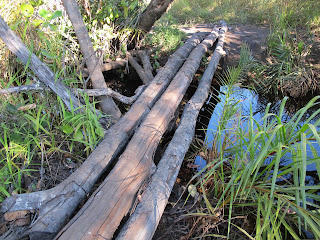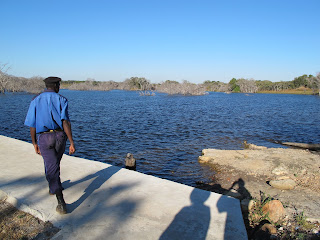This huge growth is part of the tree, not an ant mound like we found on our morning walk.
After we crossed off the traveled road we followed white spray painted spots, through a village, and next to a garden. Here are the remains of maize and other vegetation.
This is one of the white spots, but, on the same tree is white lichen ... even those white spots disappeared after a time, and it was simply be following a rather detailed description of the route that we managed to emerge at the guard station. There was a path, and where it forked we opted for the one with the most hiking boot prints.
Timed shots ... gosh! It isn't until we see photos that we realize we really are middle aged .. no more skinny people. Time to get busy with morning crunches and walking!!!
This is the dries place, overlooking rocky outcrops. The burned tree on the right of the photo below is the aftermath of the regular burning that takes place. If you've notice in some of the larger scenery shots the haze, that is from burning. At one point on the highway the guard rails were on the ground because the posts were either severely charred, or simply burnt away.
Mushrooms growing on a dead, still standing tree trunk:
Sitting on one of the outcrops. It was limestone with a dark covering (probably from burning brush over who knows how many years). That is cacti behind us.
After walking across the browned grasslands, we entered a more jungle-like area. This is one of several foot "bridges" we used to cross the streams. When a log gets rotted enough, they just toss another one on top.
And bent, hammered rebar is how the logs are held together.
Our directions told us to look for the palm tree, confirming we were still on the right path.
Because we didn't want to cause any more distress than we needed, the guard station was not photographed. This is the guard who accompanied us to the mini-hydro. Here he is walking on the dam, and we are overlooking the lake created by the dam.
Because of the time of year, and the less abundant rainfall during the wet season, the level of the lake was down by quite a bit. Tom asked "Jeremiah" about fishing, and he said that they were no longer allowed to fish. Then we learned later from Mark Harvey this was because they would sew lengths of mosquito netting together, stretch it across and overfish. And he assured us that if we had been able to inspect the police tent/headquarters at the dam, we would have seen several bundles of mosquito netting. Conservation is not part of their ethos.
A Chinese construction firm came in to construct the dam, and help commission the mini-hydro plant. Unfortunately, Zesco employees have already managed to damage the hydro plant, necessitating a return visit from the Chinese. The concrete was all mixed by dumping aggregate, hoeing in cement and then mixing in water .. on the ground. No mixers, except human ones. The Chinese had a difficult time finding enough Zambians willing to work as hard as they did, but eventually the dam was completed. It is really rather impressive when you realize how it was built, and it is well built.
Downstream are the Chusa Falls:
The spillway for the dam.
More of the falls, from the spillway:
This canoe is hacked out of a single log, and Jeremiah told us it takes about a week complete one boat.
This one is abandoned, just left to sit half out of the water. You can see where metal sheets were nailed on to try to extend the life.






















No comments:
Post a Comment